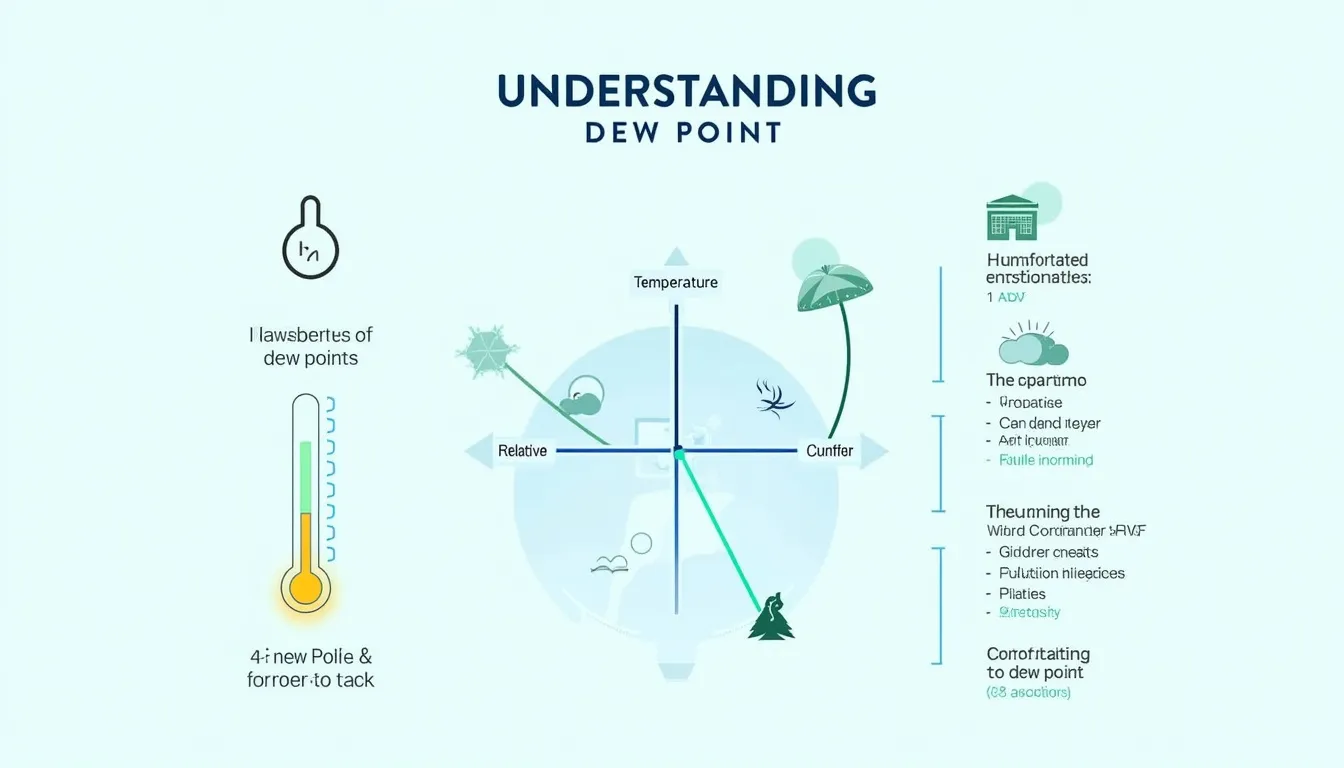Dew Point Calculator
Is this tool helpful?
How to Use the Dew Point Calculator Effectively
Step-by-Step Guide
Follow these simple steps to calculate the dew point temperature using our user-friendly tool:
- Enter Ambient Temperature: Input the current air temperature in the “Ambient Temperature” field. For example, you might enter “25” if the temperature is 25°C or 77°F.
- Select Temperature Unit: Choose either Celsius (°C) or Fahrenheit (°F) from the dropdown menu to match your input temperature.
- Input Relative Humidity: Enter the current relative humidity as a percentage in the “Relative Humidity (%)” field. For instance, if the humidity is 60%, you would enter “60”.
- Calculate: Click the “Calculate Dew Point” button to generate the result.
- View Result: The calculated dew point temperature will be displayed below the form in the same unit as your input temperature.
Sample Inputs
Here are some sample inputs to help you get started:
- Ambient Temperature: 30 (°C)
- Temperature Unit: Celsius (°C)
- Relative Humidity: 75%
Or for Fahrenheit users:
- Ambient Temperature: 86 (°F)
- Temperature Unit: Fahrenheit (°F)
- Relative Humidity: 75%
Understanding Dew Point: Definition, Purpose, and Benefits
What is Dew Point?
The dew point is the temperature at which air becomes saturated with water vapor, causing condensation to occur. It’s a critical meteorological concept that helps us understand atmospheric moisture content and its effects on our environment and comfort.
Purpose of the Dew Point Calculator
Our Dew Point Calculator serves several important purposes:
- Accurately determine the dew point temperature based on ambient temperature and relative humidity
- Help users understand the relationship between temperature, humidity, and moisture condensation
- Provide valuable information for weather forecasting, HVAC system design, and personal comfort assessment
- Assist in predicting potential issues related to moisture, such as fog formation or mold growth
Benefits of Using the Dew Point Calculator
Utilizing our Dew Point Calculator offers numerous advantages:
- Precision: Get accurate dew point calculations based on the widely-used Magnus formula
- Convenience: Quickly obtain dew point values without complex manual calculations
- Flexibility: Switch between Celsius and Fahrenheit units to suit your preference
- User-Friendly Interface: Easy-to-use design suitable for both professionals and enthusiasts
- Instant Results: Receive immediate dew point temperature outputs for efficient decision-making
The Science Behind Dew Point Calculation
The Magnus Formula
Our Dew Point Calculator employs the Magnus formula, a widely accepted empirical method for calculating dew point temperature. This formula provides accurate results within typical atmospheric conditions.
The mathematical representation of the Magnus formula is as follows:
$$\alpha = \frac{aT}{b+T} + \ln\left(\frac{RH}{100}\right)$$$$T_d = \frac{b\alpha}{a-\alpha}$$Where:
- $$T$$ is the ambient temperature in °C
- $$RH$$ is the relative humidity in %
- $$T_d$$ is the dew point temperature in °C
- $$a = 17.27$$ and $$b = 237.7°C$$ are constants
Temperature Unit Conversions
For Fahrenheit inputs, our calculator first converts the temperature to Celsius, performs the calculation, and then converts the result back to Fahrenheit if necessary. The conversion formulas used are:
$$T_C = \frac{(T_F – 32) \times 5}{9}$$$$T_F = \frac{T_C \times 9}{5} + 32$$Practical Applications of the Dew Point Calculator
Weather Forecasting and Meteorology
Meteorologists rely on dew point calculations to:
- Predict fog formation and visibility issues
- Estimate cloud base heights for aviation purposes
- Assess the likelihood of precipitation
- Determine the potential for severe weather events
HVAC System Design and Operation
HVAC professionals use dew point information to:
- Size air conditioning systems appropriately
- Prevent condensation on cooling coils and ductwork
- Optimize dehumidification processes
- Maintain indoor air quality and comfort
Agriculture and Crop Management
Farmers and agricultural specialists utilize dew point data to:
- Predict frost formation and protect sensitive crops
- Manage irrigation schedules effectively
- Assess the risk of fungal diseases in plants
- Optimize greenhouse climate control
Personal Comfort and Health
Individuals can use dew point information to:
- Understand how humidity affects perceived temperature
- Plan outdoor activities for optimal comfort
- Manage indoor humidity levels to prevent mold growth
- Assess potential triggers for respiratory issues
Example Calculations and Use Cases
Example 1: Summer Weather Forecast
Let’s consider a summer day with the following conditions:
- Ambient Temperature: 28°C (82.4°F)
- Relative Humidity: 65%
Using our Dew Point Calculator, we find that the dew point temperature is approximately 20.5°C (68.9°F). This high dew point indicates muggy conditions and a possibility of afternoon thunderstorms.
Example 2: Winter Indoor Air Quality
In a heated indoor environment during winter:
- Ambient Temperature: 22°C (71.6°F)
- Relative Humidity: 30%
The calculator yields a dew point of about 3.8°C (38.8°F). This low dew point suggests dry air, which might cause discomfort and static electricity issues.
Example 3: Greenhouse Management
For a greenhouse environment:
- Ambient Temperature: 26°C (78.8°F)
- Relative Humidity: 80%
The calculated dew point is approximately 22.4°C (72.3°F). This high dew point indicates a risk of condensation on plant leaves, potentially promoting fungal growth.
Understanding Dew Point and Its Relationship to Comfort
Dew Point and Perceived Comfort
The dew point temperature strongly influences how we perceive comfort. Here’s a general guide:
- Below 10°C (50°F): Comfortable and dry
- 10-15°C (50-59°F): Comfortable
- 16-18°C (60-64°F): Slightly uncomfortable
- 19-21°C (65-70°F): Uncomfortable, humid
- Above 21°C (70°F): Very uncomfortable, oppressive
Dew Point vs. Relative Humidity
While relative humidity changes with temperature, dew point remains constant for a given amount of moisture in the air. This makes dew point a more reliable indicator of actual humidity levels and comfort.
Frequently Asked Questions (FAQ)
Q1: What is the difference between dew point and frost point?
A1: The dew point is the temperature at which water vapor condenses into liquid water. The frost point, on the other hand, is the temperature at which water vapor transitions directly into ice, bypassing the liquid phase. This occurs when the dew point is below freezing (0°C or 32°F).
Q2: Can the dew point be higher than the actual temperature?
A2: No, the dew point cannot be higher than the actual air temperature. At most, it can equal the air temperature, which would result in 100% relative humidity and potential precipitation or fog formation.
Q3: How does altitude affect dew point calculations?
A3: Altitude itself doesn’t directly affect dew point calculations. However, as altitude increases, air pressure and temperature typically decrease, which can indirectly influence the dew point. Our calculator assumes standard sea-level pressure for its calculations.
Q4: Why is dew point important for HVAC systems?
A4: Dew point is crucial for HVAC systems because it helps determine the temperature at which condensation will form on cooling coils and other surfaces. This information is vital for preventing moisture-related issues and maintaining optimal system efficiency.
Q5: How often should I check the dew point?
A5: The frequency of checking the dew point depends on your specific needs. For general comfort assessment, checking daily or when weather conditions change significantly is usually sufficient. For specialized applications like agriculture or HVAC management, more frequent monitoring may be necessary.
Enhancing Your Understanding of Atmospheric Moisture
The Water Cycle and Dew Point
Understanding dew point is crucial for comprehending the water cycle. As air cools to its dew point, water vapor condenses, forming clouds, fog, or dew. This process is fundamental to precipitation and plays a vital role in global water distribution.
Climate Change and Dew Point Trends
Climate scientists monitor dew point trends as indicators of climate change. Rising dew points can signify increased atmospheric moisture content, potentially leading to more frequent and intense precipitation events in some regions.
Dew Point in Various Climates
Dew point characteristics vary significantly across different climate zones:
- Tropical Climates: High dew points year-round, often above 20°C (68°F)
- Desert Climates: Low dew points due to minimal atmospheric moisture
- Temperate Climates: Varying dew points with seasonal changes
- Polar Climates: Very low dew points, often below freezing
Advanced Applications of Dew Point Knowledge
Industrial Processes
Many industries rely on precise dew point control:
- Food Processing: Maintaining proper humidity levels to prevent spoilage
- Pharmaceutical Manufacturing: Ensuring product stability and quality
- Electronics Production: Preventing moisture-related damage to sensitive components
- Compressed Air Systems: Avoiding condensation and corrosion in pipelines
Energy Efficiency
Understanding dew point can lead to significant energy savings:
- Optimizing cooling and dehumidification processes in buildings
- Improving efficiency of industrial drying operations
- Enhancing performance of renewable energy systems like solar panels
Environmental Monitoring
Dew point measurements are valuable for various environmental applications:
- Assessing air quality and pollution dispersion patterns
- Studying ecosystem dynamics and plant-atmosphere interactions
- Monitoring and preserving sensitive artifacts in museums and archives
Conclusion: Empowering Users with Dew Point Knowledge
Our Dew Point Calculator is more than just a tool—it’s a gateway to understanding the complex interplay between temperature, humidity, and atmospheric moisture. By providing quick and accurate dew point calculations, we empower users to make informed decisions in various fields, from meteorology and agriculture to HVAC design and personal comfort management.
Whether you’re a professional seeking precise data for technical applications or an individual curious about your local weather conditions, this calculator offers valuable insights into the invisible yet crucial world of atmospheric moisture. By understanding dew point, you gain a deeper appreciation for the subtle environmental factors that shape our daily lives and the world around us.
We encourage you to explore the many applications of dew point knowledge and use our calculator as a starting point for further learning and discovery in the fascinating realm of atmospheric science.
Important Disclaimer
The calculations, results, and content provided by our tools are not guaranteed to be accurate, complete, or reliable. Users are responsible for verifying and interpreting the results. Our content and tools may contain errors, biases, or inconsistencies. We reserve the right to save inputs and outputs from our tools for the purposes of error debugging, bias identification, and performance improvement. External companies providing AI models used in our tools may also save and process data in accordance with their own policies. By using our tools, you consent to this data collection and processing. We reserve the right to limit the usage of our tools based on current usability factors. By using our tools, you acknowledge that you have read, understood, and agreed to this disclaimer. You accept the inherent risks and limitations associated with the use of our tools and services.







